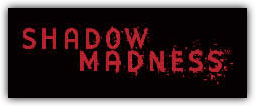
 |
|
Shadow Madness begins, in traditional RPG fashion, with an upstanding youth, Stinger, returning home just in time to see his hometown be destroyed by a mysterious, powerful force from above. Stinger leaves for the capital to seek answers to the devastation of his town and family - hooking up, of course, with a motley crew along the way. His search for answers unveils more than physical destruction - a mental illness, the "shadow madness," is sending the citizens of Arkose into schizophrenic rages. Who or what is causing this disease? And how can it be stopped?
The story of Shadow Madness is undoubtedly its strongest point. Written by native English speakers for an English-speaking audience, it has a maturity, naturalness, and wittiness found only in the best RPG translations. Just as players of Working Designs games find themselves seeking out NPCs and townsfolks because they're so funny, Shadow Madness players seek out books and pamphlets because they're so interesting The library becomes a favorite hangout spot; the history of Shadow Madness' universe is rich with detail and nuance, and it's clear a lot of work went into the game's script and writing. Unfortunately, this compelling storyline is populated by some of the most atrocious character designs in all of RPG history. Stinger is the offspring of Final Fantasy VII's Cloud and a Village Person; Harv-5 had a former life as the mascot of some second-run Mexican restaurant. And while not every RPG female need be a ridiculous caricature of femininity, Windleaf is just unattractive. The rest of the crew is just as miserable - it's a painful parade of Saturday morning cartoon rejects.
The graphics are a decidedly mixed bag. The rendered backgrounds are sharp, detailed, and get the job done just fine. The battle models aren't half-bad, but spotty camera work somehow manages to always find the most distant, least interesting angle. Spells and special attacks are straight out of the school of "uninspired polygonal effects." Character art for party members and NPCs is almost ridiculously bland. Field map character representations somehow look blockier and less human than Final Fantasy VII's infamous "popeye people" - they seem "modeled" entirely from geometric primitives. And the FMV is pretty rank, with poor modelling and a choppy frame rate. When Final Fantasy VII's in-engine summons look superior to Shadow Madness' FMV summons, something is amiss. The sound is universally quite good. The music is suitably moody and restrained, perfectly matching the title's darker tone, and sound effects often do a great job in creating an environment's atmosphere. The gameplay itself is subpar, aping Final Fantasy VII at every turn. The field exploration is just as you would expect from the super-deformed school of pre-rendered backgrounds. The battle engine unfortunately falls into the "attack, attack, attack, heal" school of "strategy," although elemental effects are more useful than in most titles. The game's interfaces are glaringly clunky; awkward and unintuitive, they don't offer nearly enough complexity while removing functionality. In the end, Shadow Madness isn't good enough to recommend, but not so terribly bad that it should be avoided outright. Despite being highly flawed, it has a lot going for it - and just as much holding it back. Like the American-made Secret of Evermore, Shadow Madness goes through the motions of Japanese RPGs without ever understanding what makes the games it copies so popular in the first place. If RPGs were dating prospects, then Shadow Madness is the ugly girl with the great personality. And no one wants to make it with a personality. Some gamers will dismiss the game before even playing it; others will find it one of their favorite RPGs ever. Shadow Madness is a diamond in the rough that you've got to mine yourself - interested gamers should at least give it a chance. Review by Andrew Vestal, GIA. |
|
||||||||||||||||||||||||||||||||||||||||||||



